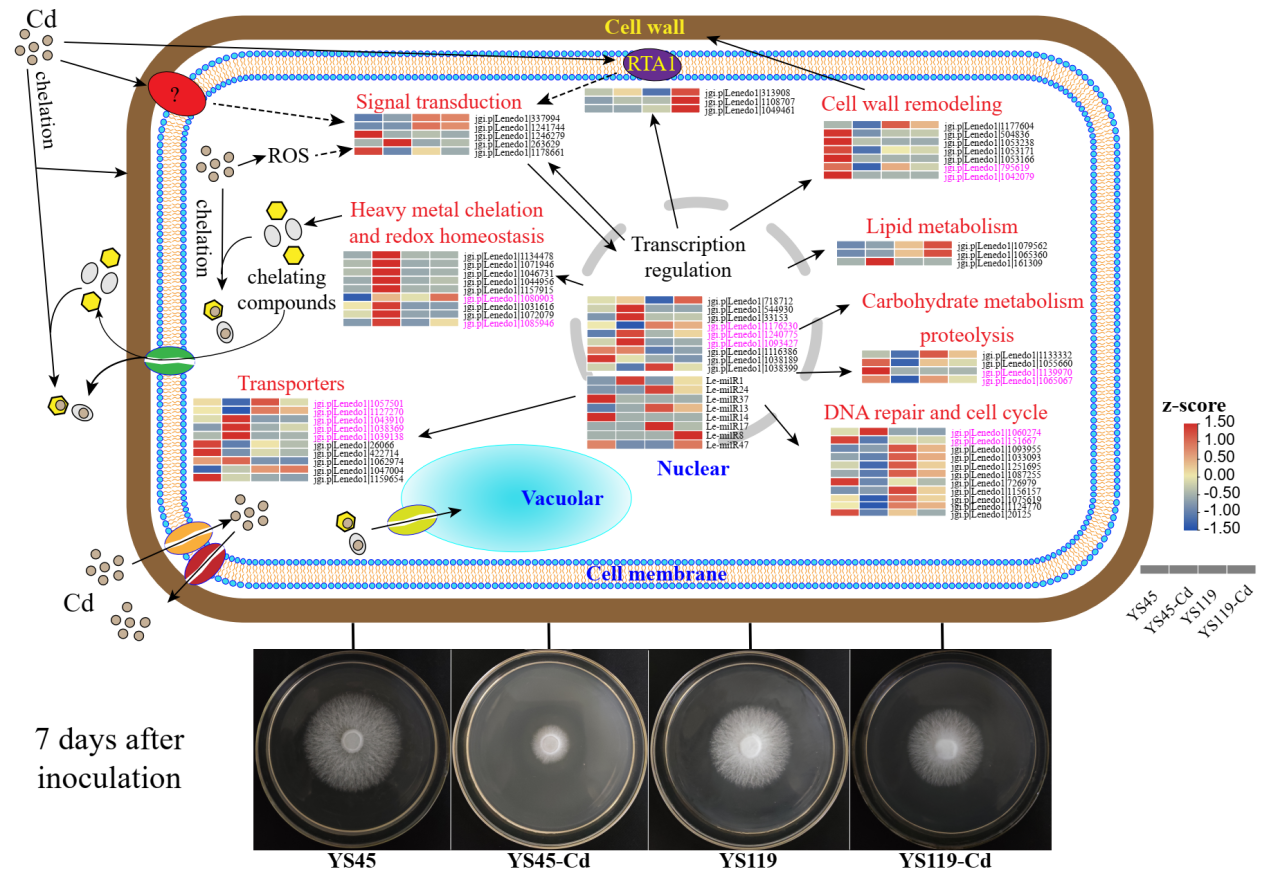南湖新闻网讯(通讯员 沈楠)8月24日,我校植物科学技术学院边银丙教授领衔的应用真菌团队在国际学术期刊Journal of Hazardous Materials上在线发表了题为“Molecular mechanism underlying cadmium tolerance differentiation in Lentinula edodes as revealed by mRNA and milRNA analyses”的研究论文。
该研究使用mRNA和milRNA联合分析的方法解析了香菇镉耐受性分化的分子机制,并验证了α淀粉酶基因LeAmy在增强香菇镉耐受性中的作用,为选育适宜于重金属修复的香菇优良品种奠定了重要的理论基础,这也是milRNA调控大型真菌镉耐受性的首次报道。
生物重金属耐受能力和生物修复能力具有重要的研究价值,香菇不同菌株间镉耐受能力存在显著差异。香菇对重金属镉耐受性分化研究对耐基质镉污染的优良品种选育,以及利用香菇菌渣进行环境镉污染修复,都具有重要的科学意义。研究团队通过mRNA和milRNA联合分析揭示了香菇镉耐受性分化的分子机制,细胞壁重塑、转运、重金属鳌合、脂质和碳水化合物代谢、转录调控、氧化还原稳态、蛋白水解、信号转导、DNA修复和细胞周期相关的基因及milRNA的差异表达调控导致了菌株间的镉耐受性分化,进一步建立了香菇镉耐受性分化的分子机制模型。
研究团队还通过遗传转化验证了重要候选基因LeAmy的生物学功能。过表达LeAmy基因,镉敏感菌株YS45的镉耐受能力显著提升,且在镉处理条件下产生的蛋白聚集体明显减少,而脂滴数量增加。结果表明LeAmy基因可增强香菇镉耐受能力,碳水化合物及脂质代谢、蛋白水解等生物学过程可影响香菇镉耐受能力。

图1 香菇镉耐受性分化的分子机制模型

图2 LeAmy基因提高香菇镉耐受能力
博士生沈楠和硕士生徐晨杰为论文共同第一作者,肖扬副教授为通讯作者。相关研究获得了国家自然科学基金、国家食用菌产业技术体系和湖北省食用菌产业技术体系等项目的资助。通讯作者肖扬副教授一直从事香菇等食用菌的遗传研究,近年来在Journal of Hazardous Materials,Journal of Advanced Research,Computational and Structural Biotechnology Journal,Journal of Fungi,Scientia Horticulturae 等学术期刊发表了一系列研究成果。
审核人:边银丙
【英文摘要】
Lentinula edodes is an important candidate for heavy metal mycoremediation. This study explored the molecular mechanism of cadmium (Cd) tolerance differentiation of L. edodes through comparative mRNA and milRNA analyses of two strains, YS45 (Cd sensitive) and YS119 (Cd tolerant). Results showed the emergence of more possible protein aggregates in YS45 than in YS119 under Cd stress. The number of differentially expressed genes (DEGs) and milRNAs (DEMs) was identified as 2,036 and 370 as well as five and three in YS45 and YS119, respectively. Comparison of DEGs and DEMs between the two strains revealed that genes and milRNAs involved in cell wall remodeling, transport, heavy metal chelation, lipid and carbohydrate metabolism, transcription regulation, redox homeostasis, proteolysis, signaling, DNA repair, cell cycle, may play important roles in Cd stress response, and their different expression patterns, especially those associated with proteolysis and carbohydrate metabolism, might lead to Cd tolerance differentiation between the two strains. The function of the α-amylase gene LeAmy in enhancing Cd tolerance in L. edodes was further verified by overexpression. This study has shed light on the molecular mechanism of Cd tolerance differentiation in L. edodes, and laid a foundation for breeding elite strains for heavy metal mycoremediation.
论文链接:https://www.sciencedirect.com/science/article/pii/S030438942201634X

